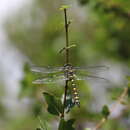Biology
provided by Arkive
Virtually nothing has been recorded of the Greek goldenring's biology and behaviour, but this may be inferred from what is known about C. bidentata, which has a similar structural morphology and habitat. The eggs should hatch 2 to 11 weeks after egg deposition and the larval period should last 2 to 6 years, depending on the altitude. It should include around 15 stadia. After metamorphosis and emergence, adults, which are, like other Odonata species, generalised, opportunistic feeders, feed on flying insects. Males don't establish territories but patrol over long distances along river edges, searching for reproductive females, and standing quite often on herbs or branches exposed to the sun. Females are generally hidden and are much more scarcely observed than males. They lay by driving their eggs in the sandy sediments of rivers and brooks through a rhythmic vertical flight, distinctive of golden-ringed dragonflies (4).
Conservation
provided by Arkive
No conservation measures currently target this species, but there is a need for control of water use and forest preservation (1).
Description
provided by Arkive
Also referred to as spiketails and biddies, golden-ringed dragonflies (Cordulegastridae) are large black dragonflies with generally bright yellow rings more or less encircling their abdomen, depending of the species (2) (3). The Greek goldenring exhibits wide abdominal yellow rings, possesses conspicuous yellow markings on the thorax and the head and has large green eyes. Males and females are similar in appearance but females are distinctly larger. Separation from the Turkish C. insignis is mainly possible through the more squarish and flat back part of the occipital triangle (ovoid and swollen in insignis), its green eyes (generally bluish in insignis) and the tapering shape of the male inferior appendage (sides parallel in insignis) (2).
Habitat
provided by Arkive
Found along springs and spring-brooks (head-water systems), and perhaps even larger brooks (1).
Range
provided by Arkive
Endemic to southern Greece, including the Peloponnese Peninsula, prefectures of Attica and Phokis, south-eastern part of Fthiotida prefecture, and the islands of Evia, Andros, Tinos and Naxos (1).
Status
provided by Arkive
Classified as Vulnerable (VU) on the IUCN Red List 2006. Subspecies: Cordulegaster helladica buchholzi, C. h. helladica and C. h. kastalia (1).
Threats
provided by Arkive
Populations appear to be severely fragmented, and some previously reported sites have recently been found dry and deserted as a result of water extraction for human use. Thus, the population is believed to be declining due to habitat destruction, caused at least in part by water harnessing by humans (1).
Cordulegaster helladica
provided by wikipedia EN
- license
- cc-by-sa-3.0
- copyright
- Wikipedia authors and editors
Cordulegaster helladica: Brief Summary
provided by wikipedia EN
Cordulegaster helladica is a species of dragonfly in the family Cordulegastridae. It is endemic to Greece. Its natural habitats are subtropical or tropical dry forests, rivers, and freshwater springs. It is threatened by habitat loss.
- license
- cc-by-sa-3.0
- copyright
- Wikipedia authors and editors

